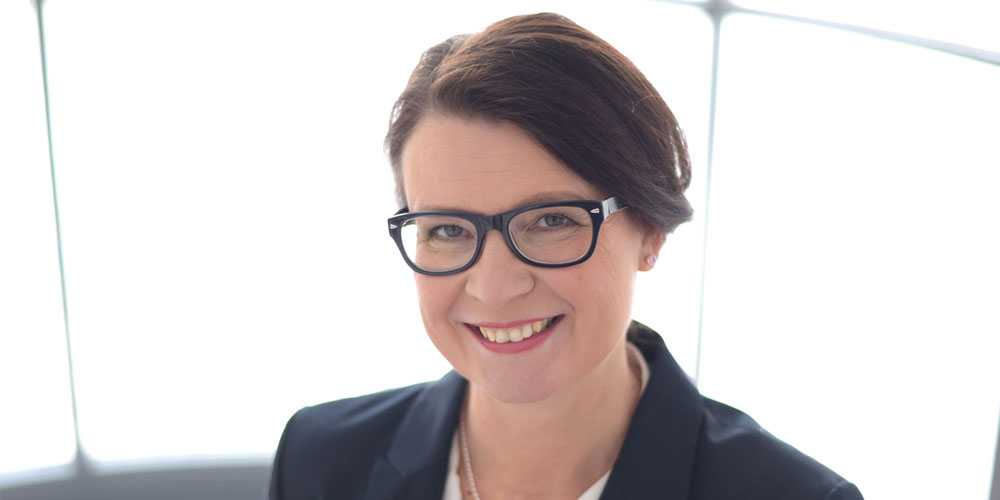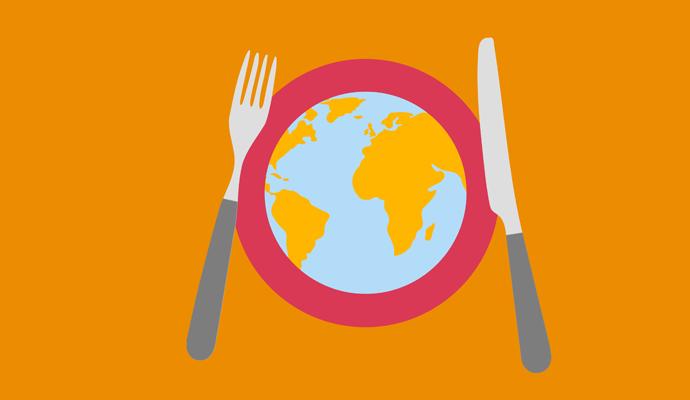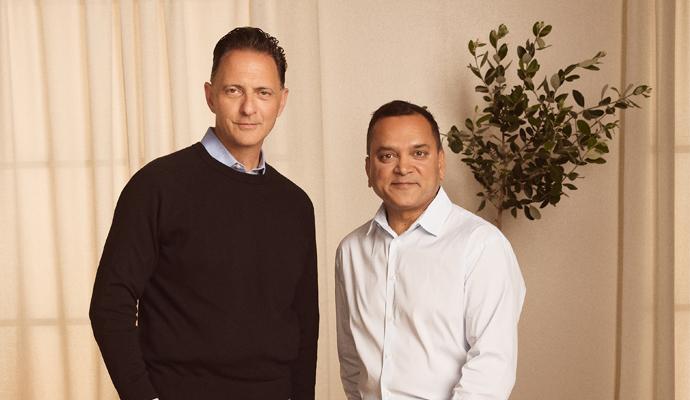Finnish dairy company Valio is feeding the future
CEO Annikka Hurme on innovating for growth and sustainability.
A version of this article appeared in the Summer 2022 issue of strategy+business.
This interview is part of the Inside the Mind of the CxO series, which explores a wide range of critical decisions faced by chief executives around the world.
Walk the aisles of any shop or market in Finland, and you are likely to encounter a diverse selection of Valio products. Whether it’s the company’s milk, cheese, butter, or yogurt, its offerings have long been synonymous with quality and innovation, and a source of Finnish pride. The Helsinki-based dairy and food company has been producing milk since 1905, when it was founded by a small group of family-owned Finnish dairy farms.
Today, Valio—with net sales of €1.8 billion (US$2 billion)—is a private company that is still owned by the 4,000 cooperative family farms that produce its milk. Led by CEO Annikka Hurme, Valio is Finland’s biggest food exporter, selling products in some 60 countries around the world. The company employs about 4,200 people in its factories and laboratories, and has subsidiaries in Russia, Sweden, the Baltics, the US, and China. In addition, Valio indirectly employs thousands of people at farms and small enterprises related to agriculture and food. Hurme joined Valio in 1989 after earning a degree in food economics from the University of Helsinki and held several leadership roles within different business units; she was appointed CEO in 2014, when the company was struggling in the aftermath of a Russian import embargo. As part of Hurme’s vision to accelerate growth, Valio entered the plant-based sector in 2018, with its oat-milk brand Oddlygood.
This new offering, which appeals to shifting consumer preferences, is also consistent with Valio’s efforts to build an environmentally responsible business. Finnish consumers selected the company as the most sustainable brand in the country in 2021, for the eighth consecutive year. Sustainability is particularly important to dairy companies. In 2019, the New York Times reported that the dairy industry contributes 3.6% of global greenhouse gas emissions. In 2018, Valio committed to a net-zero carbon footprint for milk by 2035 and is pursuing a variety of initiatives to achieve this goal. In an interview with strategy+business, Hurme explained the company’s innovative approach to growth and sustainability.
S+B: Valio is owned by its dairy farmers. What are some of the benefits and challenges of this structure?
HURME: One of the benefits for me and for the other company leaders at Valio is that our purpose and our mission are clear. We know that the company’s owners are farmers who want to keep their business alive, generation after generation. We also know what our farmers want us to do, first and foremost: to maximize the value of the raw milk they produce.
Of course, our structure also presents some challenges. The profits we bring in from the customer go back to our owners. But we also need to keep money in the company to innovate and develop our brand portfolio. Fortunately, our owners understand why we have to think about the future, not just next week’s or next month’s results. They never cut resources from our R&D organization.
We’re also working with our owners to respond to the rise of global trends toward vegetarianism and more climate-friendly food. In that discussion, it is important that we know our own climate impact and actively reduce it. Our owners understand that it is necessary to be active in different fields—for example, that we both pursue sustainable milk production and play a role in the plant-based sector.
S+B: How have you framed this conversation—about entering a competing sector—with your farmers?
HURME: We see that people are increasingly consuming plant-based products. Why not take our share in that growing segment? We can earn more money. And we can use the R&D capabilities and operations that we have—we can use the same factories, the same logistics, the same sales force, and the good market position we have established to compete in the plant-based, dairy-substitute category. We had also entered other nondairy categories decades before, such as fruit juice and [a Finnish specialty] berry soup.
In fact, in the plant-based category, we have the chance to be a very innovative player and a market leader. We entered this space in 2018 with the launch of Oddlygood, and sales have doubled each year since. We want to develop a whole range of plant-based products in the future. It’s not because we want to produce less milk; it’s because we want to grow.
In May 2021, we spun off the business operations of Oddlygood to form Oddlygood Global. We did this to further enable the commercial utilization of our company’s expertise and to pursue international growth. We have to think a bit differently in this space to make sure that we will be successful. Because our primary mission is to maximize the price of our farmers’ raw milk, it makes sense for us to create a partnership network so we can raise capital from other sources to grow our plant-based offerings. [In December 2021, Finnish private equity firm Mandatum Asset Management announced an investment of €25 million (US$28 million) in Oddlygood Global.]
S+B: What other trends are shaping your growth strategy?
HURME: We’ve seen increased preference for products with less sugar and more protein. For example, we have developed lactose-free milk powders with various added ingredients that we can offer to chocolate companies. By using the powders, they can maintain the quality and taste of their chocolate, with less sugar. This is something very specific that we can do for our customers that sets us apart from competitors. Everyone can offer lactose-free; our advantage is that we can lower the sugar content.
We’ve seen increased preference for products with less sugar and more protein. This is something very specific that we can do for our customers that sets us apart from competitors.”
Moreover, when we think about food, the taste is very important. We are always thinking about people who cook at home, and how they can make a better meal by using cream with a different base, such as pepper or cheese. And people want to have pre-sliced cheese and other easy-to-serve food products in their kitchen, as well as family packs that can feed their whole household.
We’re constantly monitoring how the consumer thinks and then considering how to adjust accordingly. Some of our factory leaders sometimes say that we have too many stock-keeping units [SKUs] compared to our overall efficiency. But we need to have different kinds of products, package sizes, flavors, sugar levels, fat levels, ingredients, vitamins, and so on. And our product development has to be fast to make sure that we can maintain our market-leader position or gain more market share in other areas. Looking ahead, I believe there will also be laboratory-made food in our pipeline. As an innovative food and dairy company, we want to be part of these changes. Perhaps in the future, people won’t be thinking about plant-based or milk-based, but instead about what they need and how it tastes.
S+B: What kind of variation is there among the markets in which you sell?
HURME: Sometimes it’s in the messaging. In Finland, we say that there is “no lactose” in a product. But in China, we may sell the same products but say that they are for “sensitive stomachs.” Among our Chinese customers, we’ve found that if we say a product is lactose-free, the perception is that it is because we have taken something away, it’s not natural. In other countries, we say there is “less energy” in the product, because when it is lactose-free, there’s less milk sugar.
There are also different flavor preferences. In Sweden, our customers love vanilla and strawberry yogurt. In Estonia, they love cherry, but in Finland, no one wants cherry-flavored yogurt—I love this flavor, however, and get it when I’m in Estonia. We have to make sure that we understand the local demand when we think about food, and how we communicate the story of the products.
S+B: On the topic of different markets, how much of a focus is international expansion for Valio?
HURME: We are the market leader in Finland in both dairy and oat-based substitutes. But currently, about 40% of our sales come from outside Finland, in particular in Estonia and Russia, and also some in the US. We export to some 60 countries in total. We recognize that in the future, we are going to grow outside Finland. One reason is that the population in Finland [about 5.5 million] is declining, and of course we are not able to eat more than we do today.
As we look to new markets, I believe we have an edge over some of our much bigger international competitors. We are fast enough to execute new ideas based on what we’re doing in our R&D laboratories. Our production lines are agile enough to manufacture those innovations at an industrial scale. Some of our competitors are already so efficient with their production that there is no time to do pilot tests.
Of course, there are also some barriers. Because we are accustomed to being a market leader domestically, we need to make sure we have the right mindset as we shift to becoming a challenger in another market. Launching a new product under those circumstances is much more difficult. We also have to be able to explain to the owners that we won’t get their money back as quickly. When we are doing something in Finland, because of the scale we have here, it’s easier to get the money back from the market—we have the logistics, we have the sales force, we have the brand awareness. In a new market, it’s going to take time, and that’s the most difficult part to explain.
We have been an export business for more than 100 years, so we have learned a lot. We have a special team that manages the specific issues that arise in each market that we operate or sell in. Here in Finland, we have a working relationship with the authorities, and our local connections are helpful in navigating EU regulations. But as we expand, we need to think about many new things—for example, being halal or kosher. The variation is huge. There will also increasingly be sustainability requirements that will look different from country to country.
S+B: In 2014, access to one of your major export markets, Russia, was cut off by an import embargo. What were the organization’s key takeaways from such a major disruption?
HURME: In a way, we were lucky, because we had just finished a big investment in a milk powder factory in Lapinlahti [a municipality in eastern Finland]. We were able to reallocate the milk that we were going to export to Russia for use in yogurt and other fresh products. Although our profits went down, we were able to handle the milk volume. Most important, in that moment, we realized that our logistics operations and how we run our factories were in top form.
I think that after the embargo, we were ready for the pandemic. In just a few hours [in March 2020], we put a special team in place whose only task is to make sure that the daily work goes on. And then others were able to continue to execute the strategy. We understand that when there is a crisis, you have to adjust, but at the same time, you have to keep going. Don’t stop your innovations. Don’t stop developing the business.
S+B: Valio is also confronting climate risk and has set a target to cut milk’s carbon footprint in Finland to zero by 2035. Can you talk about the company’s sustainability journey?
HURME: I’m happy that we started early, but it was not easy to set that target. For one, we had lost the big market share we had in Russia and had to bring down our raw milk price. We needed to recover from that. There were also challenges with our owners. When we first told them about our plans to reduce emissions, their thought was, wouldn’t it be easier to achieve this target in factories or logistics, versus at the farm level? They also wondered how much money they would need to spend to achieve these targets. But luckily, climate actions at farms also mean savings, as resources are used more wisely. Today, our farmers are very committed to our common goals.
We did the research and believe that we can achieve our targets: reducing emissions for milk by 50% at the farm level, 47% at the plant level, and 28% at the collection logistics level by 2030, compared to 2019 levels, and reaching a net-zero carbon footprint for milk by the year 2035. Of course, there are still some things that we don’t know today in terms of how we get there. But we are convinced we will figure them out and develop solutions during the next few years. In 2020, our targets for 2030 were validated by the Science Based Targets initiative. And then we have our additional targets that reach out further than that, to 2035.
To support the farmers in our sustainability journey, we pay them more money for their raw milk for following the rules of our program—a premium of 2 cents per liter. It’s not much per liter, but if we look at the impact on an annual level, it means €8,000 [US$8,655] additional for a farm with 45 cows, which is the average farm size at Valio.
S+B: One of your sustainability initiatives involves the production of biogas.
HURME: We are already today producing biogas from our cow manure. We’ll be able to make fuel, but also circular products such as ecological fertilizer and clear water as part of the process. Our biogas initiative is going to take a few years, but this is one part of how we can help the farmers to achieve our carbon reduction targets.
We are pursuing this initiative by creating a joint venture with St1, a Nordic energy company [with operations in Finland, Sweden, and Norway], as soon as we are approved by the EU. It’s crucial for us to have a partner who knows the biogas business and the fuel business, because we are not an expert in these areas. We have the raw materials and can arrange delivery from farms to the biogas plants. St1 can help with distribution, through its fuel stations for heavy-duty vehicles. In this way, we combine our knowledge.
The goal is to create up to 1,000 GWh of biogas production by 2030. Right now, we are lobbying the government to create subsidies so that more businesses can convert their heavy vehicles from fossil diesel to biogas. This would go a long way in helping Finland to achieve its national decarbonization targets.
S+B: What are some of the other efforts under way?
HURME: Our farmers are training in carbon farming, which aims to bind CO2 in soil rather than releasing emissions [through a focus on soil quality, deep-rooted grass, and crop rotation, among other strategies]. We are also innovating our packaging, to ensure that it is reusable or made from recycled materials. We’re collaborating with some of our packaging partners to develop innovations; for example, all our milk and yogurt carton packages are made of fully plant-based materials. Our partners here are the Finnish paper and pulp company Stora Enso and packaging solutions company Tetra Pak.
We are also changing some of the processes in our factories to make them more climate friendly. For example, in our Lapinlahti plant, our flue gas condenser investment will allow us to recover thermal energy from the on-site heating plant’s flue gases and use it to heat the plant’s processes and the facilities. We can often pay back that kind of investment to our farmers in just a few years.
S+B: What are the potential roadblocks toward achieving your sustainability goals?
HURME: My first concern is, if the EU decides that nuclear power is not green, I don’t know how we can achieve the target. Because we need so much energy, and biogas or renewable solutions such as solar and wind power are just not there yet when we think about industrial needs.
Number two is taxation. I’m concerned that politicians at the EU and national level who are eager to make things happen fast when it comes to decarbonization will make decisions that harm us—for example, by adding extra payments or new taxation that will prevent us from developing products in [a less-carbon-intensive] way.
My third concern has to do with labor shortages, both at the farm level and at the industrial level. Already now in Estonia, where we have two factories, we have to find workers from outside the country. And there is a similar situation in many other countries at the moment. This is hard, physical labor that people are increasingly less eager to do.
The good news here is that I’m not worried that we won’t develop great ideas, or that we won’t know how to do it. I’m also not worried about financing, because we can convince the investors and bankers that these initiatives are a smart green investment.
Author profiles:
- Enel Sintonen serves PwC audit clients, helping them navigate a diverse array of financial and nonfinancial reporting topics. Based in Helsinki, she is a partner with PwC Finland.
- Laura W. Geller is a senior editor at strategy+business.




